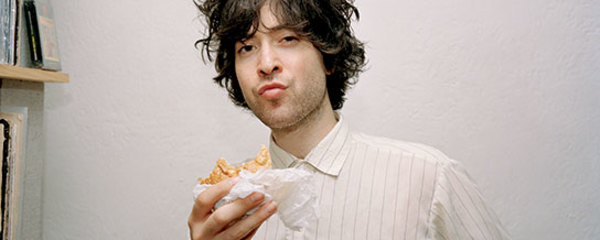Edan: Psychic Out
Look closely at the cover art of Edan’s Beauty and the Beat–a pastiche of swirling […]
Edan: Psychic Out
Look closely at the cover art of Edan’s Beauty and the Beat–a pastiche of swirling […]

Look closely at the cover art of Edan’s Beauty and the Beat–a pastiche of swirling colors with Prince Paul, Flavor Flav, and an assortment of old school hip-hop heads draped under ill-fitting afros and mod hairdos–and you might find the 30-minute whirlwind that is the MC/DJ/producer’s second album encapsulated in a nutshell.
“The colorful part of the record I ganked from some weird rock 45,” the 26-year-old Maryland native explains from his apartment in Boston’s Back Bay, as he does some last-minute record sorting for a one-off London DJ gig the next night. “I removed the titles and graphics on that record and cut out faces of the group that was in the heads of hair, and then found various hip-hop faces and put them underneath the hair. I looked at the 45 and thought ‘This represents the rock aspect of the record, but I wonder if there is a way to incorporate the hip-hop aspect visually?’”
While Edan says he was well aware that The Go-Gos already had an album called Beauty and the Beat (“But I didn’t care”), he was actually referencing Sugar Hill songwriter/session man Duke Bootee’s short-lived mid-‘80s record label, Beauty & The Beat. “I took a face or two from [those] sleeves and threw ‘em under the blonde hair,” he explains. “I was getting subtle with it for my own enjoyment or anyone else that recognizes. It all represents what I was doing musically. Taking things that already exist and throwing them in a big pot, to me, is such a fly form of art.”
A mélange of psychedelic soundscapes, abstract lyricism, and old school homages, Edan’s 13-track LP is perhaps more densely layered with samples than any full-length hip-hop album in recent memory. Although cobbled together from eclectic source material, the album finds its comfort zone connecting with late 60s/early ‘70s psych rock, a vibe its maker rounds out with some self-recorded Moog work, and loops that frequently bleed from track to track. “I didn’t look at (Beauty and the Beat) as a psychedelic record, I looked at it as a record I had to make,” Edan exhorts. “I don’t compartmentalize shit. We got to squash all these boundaries, end all the segregation in music, and just let freedom ring, son.”
Lyrically, Edan’s MC diatribes fall somewhere between MF Doom’s wistful streams of consciousness and Nas’ and KRS-One’s earnest desire to educate (“Walk out the doors and explore/With the innocence of kids age four/I frolic in the sand with a colony of ants/My particles expand/Building oxygen in plants/from Rakim to Caz/To Lakim Shabazz/Illogically advanced with the knowledge of the past” goes one particularly illustrative verse on “Making Planets”). And while listeners who’ve caught his early EPs, his debut LP Primitive Plus, and his exceptional Fast Rap mixtape (as Edan The DJ) already know how deep Edan’s passion for hip-hop runs, “Rock and Roll”’s references to The Zombies, Love, and Small Faces reveal more about his background. Born to Israeli parents in the Washington, DC suburbs, Edan Portnoy played flute and bass in a jazz ensemble and made folky four-track recordings with Dead Meadow guitarist Cory Shane before relocating to Boston to attend the prestigious Berklee School of Music.
“I have been around circles where I was just playing guitar and people didn’t know I was into hip-hop,” Edan says with a hip-hop-inflected drawl that makes this statement a little hard to imagine. “The whole spectrum starting with the Rolling Stones and The Beatles is what most of us crackers grew up around.”
While there’s no getting around the “p-word” when talking about the vibe of his new record, Edan says he didn’t do any drugs during the making of Beauty and the Beat, nor does he have a hallucinogen-addled past. “The furthest I ever took it was ‘shrooms,” he insists.
Instead, Edan says, he draws his inspiration from an earnest desire to be a part of an ongoing musical continuum that needs to look to the past as much as to the future. “We have this blessing of all this recorded art–we don’t have to be in the dark about what happened back then, which is really right now,” he explains. “We mustn’t get trapped in pushing forward. Just because something happens today does not mean it is an improvement on yesterday. That is why I study my manuscripts and my old music. I want to know how high these people have climbed, and I would like to learn from them.”

